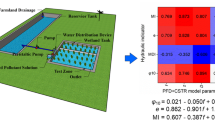Abstract
Constructed wetlands are increasingly being used to treat intermittent releases of wastewaters from aquaculture ponds. Most constructed wetland design protocols are based on steady-state releases and as such are incapable of characterizing transient pollutant distribution arising from intermittent releases. Given the seasonal nature of aquaculture operations, the constructed wetland has to be developed using water from other nearby sources (termed as fill water in this study). In some instances, the pollutant concentrations in the fill water are noted to be greater than that measured in the aquaculture ponds. Also, the pollutants in the wetland may exhibit spatial variability due to geochemical interactions with wetland soils. These effects cannot be captured with existing steady-state design schemes. A mathematical model based on the tanks-in-series conceptualization is developed to overcome the aforementioned limitations. An analytical solution for multiple intermittent releases and spatially varying initial concentrations is obtained using Laplace transform and superposition techniques. The utility of the developed model is illustrated using an example based after a constructed wetland at the Loma Alta Shrimp Aquaculture Facility (LASAF) in South Texas. The developed model captures the extremely nonlinear relationship between the maximum discharge concentration and the hydraulic residence time. For the conditions assumed in this study, the extent of mixing is not of major concern when the spacing between the loadings is greater than 0.75 times the hydraulic residence time (HRT). Model results also suggest that the wetland should be oriented in a manner such that the internal geochemical production of the pollutant, if any, is near the inlet.





Similar content being viewed by others
References
Behrends, L., Houke, L., Bailey, E., Jansen, P., & Brown, D. (2001). Reciprocating constructed wetlands for treating industrial, municipal and agricultural wastewater. Water Science and Technology, 44, 399–405.
Carleton, J. (2002). Damkohler number distributions and constituent removal in treatment wetlands. Ecological Engineering, 19, 233–248. doi:10.1016/S0925-8574(02)00094-0.
Crites, R. W., Middlebrooks, E. J., & Reed, S. C. (2005). Natural wastewater treatment systems. Boca Raton, FL: CRC.
Dadi, S. (2001). Development of a phosphorus budget for the South Texas hypersaline lagoon. Department of Environmental Engineering. Kingsville, TX: A&M University—Kingsville.
Dyke, P. P. G. (2002). Introduction to Laplace transforms and Fourier series. New York: Springer Verlag.
Dyson, B. (2005). Personal communication on LASAF operations.
Jenkins, G. A., & Greenway, M. (2005). The hydraulic efficiency of fringing versus banded wetland vegetation in constructed wetlands. Ecological Engineering, 25, 61–72. doi:10.1016/j.ecoleng.2005.03.001.
Kadlec, R. H. (1999). The inadequacy of first order treatment wetland models. Ecological Engineering, 15, 105–120. doi:10.1016/S0925-8574(99)00039-7.
Kadlec, R. H., & Wallace, S. D. (2007). Treatment wetlands (2nd ed.). Boca Raton, FL.: CRC.
Kreyszig, E. (2006). Advanced engineering mathematics. New York: Wiley.
Levenspiel, O. (1998). Chemical reaction engineering (3rd ed.). New York: Wiley.
Mankin, K. R., & Ikenberry, C. D. (2005). Batch reactor unvegetated wetland performance in treating dairy wastewater. Journal of the American Water Resources Association, 40(6), 1527–1535. doi:10.1111/j.1752-1688.2004.tb01603.x.
Mitch, W. J., & Gosseling, J. G. (2000). Wetlands (3rd ed.). New York: Wiley.
Niswinder, S. F. (1997). Treatment of dairy wastewater in a constructed wetland system:evapotranspiration, hydrology, hydraulics, treatment performance, nitrogen cycling processes. Corvallis: Oregon State University.
Persson, S. F., & Wittgren, H. (2003). How hydrologic and hydraulic conditions affect performance ponds. Ecological Engineering, (21), 259–269. doi:10.1016/j.ecoleng.2003.12.004.
Tilley, D., Badrinarayanan, H., Rosati, R., & Son, J. (2002). Constructed wetlands as recirculation filters in large-scale shrimp aquaculture. Aquacultural Engineering, 26, 81–109. doi:10.1016/S0144-8609(02)00010-9.
Uddameri, V., & Dyson, B. (2007). A decision-analytic approach for designing aquaculture treatment wetlands subject to intermittent loading under uncertainty. Water, Air, and Soil Pollution, 186, 297–309. doi:10.1007/s11270-007-9486-x.
USEPA (2000). Design manual: Constructed wetlands treatment of municipal wastewaters. Washington, D.C: United States Environmental Protection Agency.
Vadas, R. G., & Garcia, L. A. (1995). A methodology for water quantity and quality assessment for wetland development. Water Science and Technology, 31(8), 293–300. doi:10.1016/0273-1223(95)00381-V.
Walker, D. J. (1998). Modelling residence time in stormwater ponds. Ecological Engineering, 10, 247–262. doi:10.1016/S0925-8574(98)00016-0.
WEF (2001). Natural systems for wastewater treatment. Alexandria, VA: Water Environment Federation.
Werner, T. M., & Kedlec, R. H. (2000). Wetland residence time distribution Modeling. Ecological Engineering, 15, 77–90. doi:10.1016/S0925-8574(99)00036-1.
Wong, T. H. F., & Geiger, W. F. (1997). Adaptation of wastewater surface flow wetland formulae for application in constructed stormwater wetland. Ecological Engineering, 9, 187–202. doi:10.1016/S0925-8574(97)10011-8.
Wong, T. H. F., & Somes, N. L. G. (1995). A stochastic approach to designing wetlands for stormwater pollution control. Water Science and Technology, 32, 145–151. doi:10.1016/0273-1223(95)00549-3.
Wong, T. H. F., Fletcher, T. D., & Duncan, H. P. (2006). Modelling urban stormwater treatment - a unified approach. Ecological Engineering, 27, 58–70. doi:10.1016/j.ecoleng.2005.10.014.
Wormann, A., & Kronnas, V. (2005). Effect of pond shape and vegetation heterogeneity on flow and treatment performance of constructed wetlands. Journal of Hydrology (Amsterdam), 301, 123–138. doi:10.1016/j.jhydrol.2004.06.038.
Acknowledgments
I would like to thank Dr. Kim Jones and two anonymous reviewers for their thoughtful review of the manuscript. The suggestion to solve subsequent tanks using simpler ODE solution schemes without resorting to Laplace transforms by one of the reviewer greatly enhanced the understandability of the model and is highly appreciated. This material is based upon work supported by the National Science Foundation under Grant no. HRD-0206529. Any opinions, findings, and conclusions or recommendations expressed in this material are those of the author and do not necessarily reflect the views of the National Science Foundation.
Author information
Authors and Affiliations
Corresponding author
Rights and permissions
About this article
Cite this article
Uddameri, V. An Analytical Solution to Model Aquaculture Wetlands Subject to Intermittent Loading and Variable Initial Concentrations. Environ Model Assess 15, 27–35 (2010). https://doi.org/10.1007/s10666-009-9189-3
Received:
Accepted:
Published:
Issue Date:
DOI: https://doi.org/10.1007/s10666-009-9189-3




